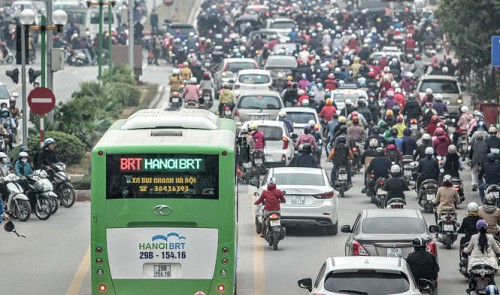The first bus rapid transit (BRT) line in Hanoi is not running at its full capacity despite having been in operation for four months.
The buses are overcrowded during rush hours while running scarce of passengers for the rest of the day.
Hanoi launched its maiden BRT line on December 31, 2016, hoping to encourage its citizens to make a switch from personal vehicles to public transport as a measure to curb worsening traffic in the city.
The route runs 14.7 kilometers between Yen Nghia bus station in Ha Dong District and Kim Ma station in Dong Da District.
However, as Tuoi Tre (Youth) newspaper noted on Saturday morning, bus stops along both directions of the BRT line were almost empty, with only 40 passengers in total boarding the bus in one trip.
These passengers said they enjoyed the bus’ modernity, though its ill-designed running schedule must be improved.
“The buses are overcrowded with passengers between 7:00-8:30 am or 5:00-6:30 pm, to the point that there are hardly any seats left,” a Ministry of Health official, who commutes from home to the ministry’s headquarters by the BRT every day, said.
“However, passengers are scarce between 12:00 and 4:00 pm.”
According to a BRT driver, the first rapid bus route is running at a five-minute interval during rush hours, and a 15-minute interval for the rest of the day.
Most passengers who take the bus during off-peak hours are retirees, he said, while there are few bus-takers who are students, because there are no BRT stops near local schools and universities.
There are currently 24 buses on the Kim Ma – Yen Nghia service, which operates between 5:00 am and 10:00 pm every day, taking around 42 minutes to cover the distance at the speed of 20-22 kilometers per hour.
The BRT allowed passengers to travel for free during its first month of operations, before charging VND7,000 per round in February. The service has since served only 42.4 passengers per trip on average, less than half of their design capacity of 90 passengers.
Wasting money?
Many experts are complaining that the BRT line, which cost more than VND1 trillion (US$44.64 million) to develop, is a waste of money that could have been put to better use by investing in conventional buses.
Nguyen Xuan Thuy, former director of the Transport Publishing House, asserted that the competence of BRTs in easing traffic is not superior to regular buses, if not less.
“BRT enjoys a separate lane for itself but so far it has failed to live up to the expected capacity, while shortening only 20 percent of running time,” Thuy said.
“That’s a complete waste of money when we put its development cost and actual effectiveness side by side.
“The money would have been better spent on regular buses.”
A transport professor also pointed out that too much money had been spent on building unnecessarily modern BRT stops, which not only takes up too much space but is also a danger to traffic safety.
The professor also criticized the decision to re-pave the entire BRT lane with concrete while the previous asphalt road was still in good condition.
“They said it was to ensure the lane’s durability, but how come trucks weighing a lot more have been rolling on the asphalt without troubles and BRT buses cannot? That’s absurd,” the professor said.
In response to these comments, Vu Van Vien, director of Hanoi’s Department of Transport, told Tuoi Tre that the BRT means of transport was still in its early stage in Vietnam, and that more experience was to be drawn from the initial implementation.
Vien added that there was “no need for worries” about the capacity of BRT buses, as the number of passengers would continue to rise in the coming time as more residential areas start to spring up along the route.
Regarding the ‘lane monopoly’ of BRT buses, Vien said Hanoi chairman Nguyen Duc Chung had approved the department’s proposal to allow regular buses onto BRT lanes in the future.
However, Vien rejected the suggestion that the concrete lane was a waste of money, since it was included in the planning “approved by relevant authorities” and was “a must”.
Hanoi is eyeing the development of eight similar BRT lines in the city, with the next expected to connect Kim Ma bus station with Hoa Lac Hi-Tech Park in Thach That District.





















































